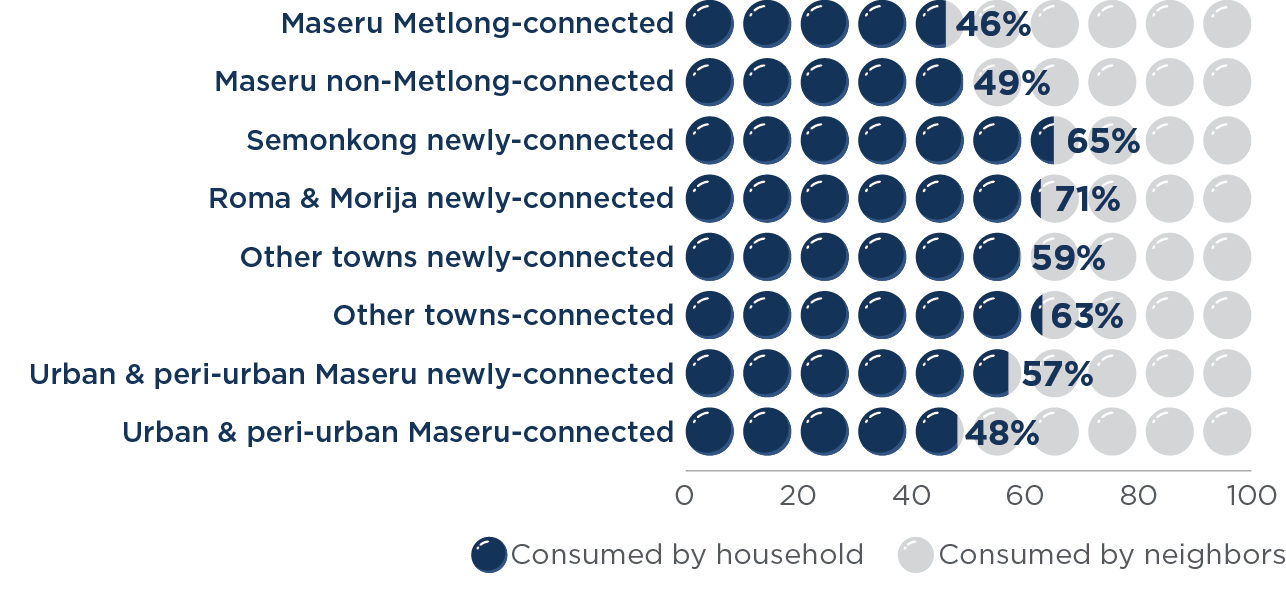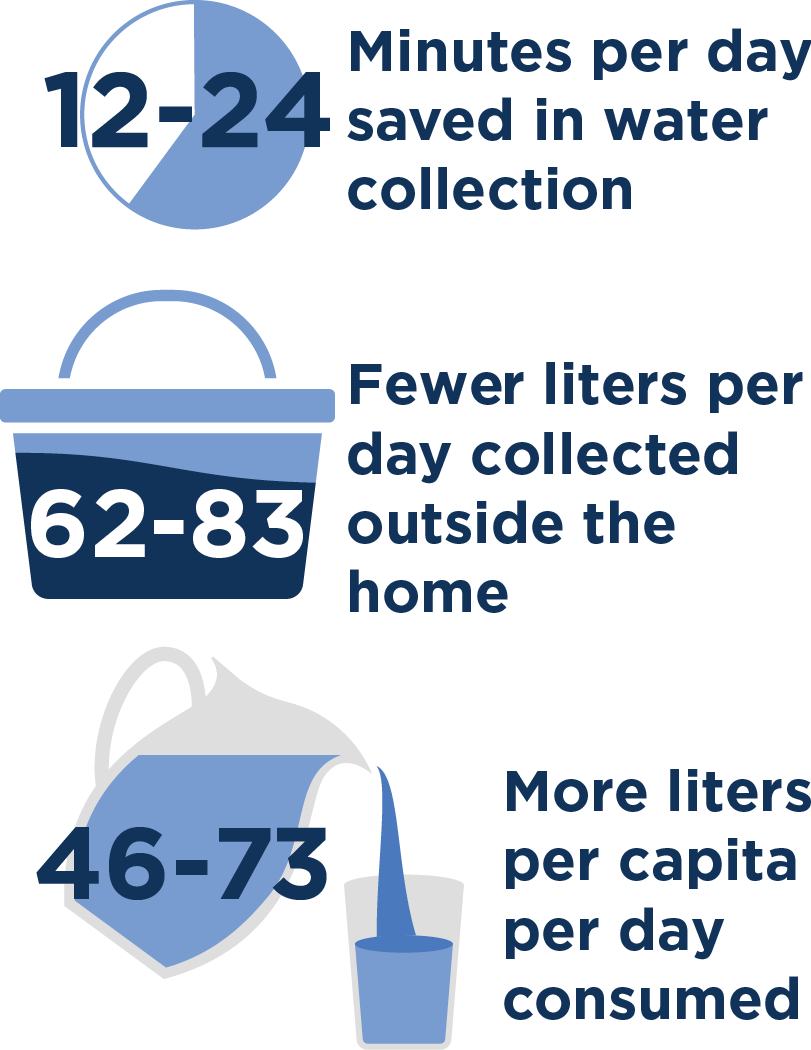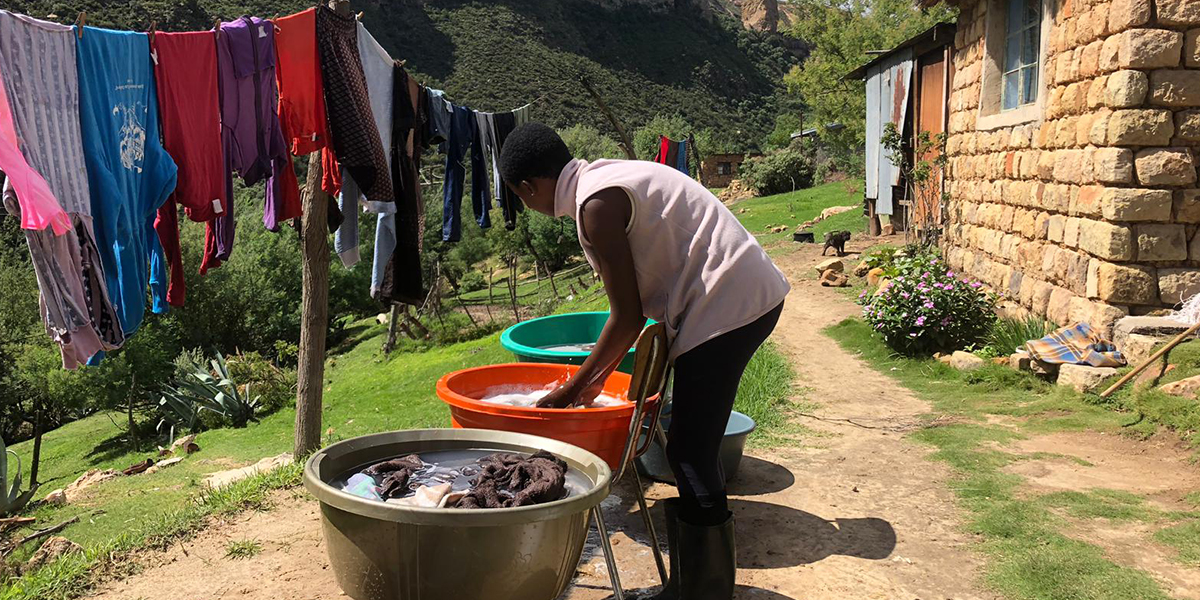Program Overview
MCC’s $362.5 million Lesotho Compact (2008–2013) provided $105.6 million toward the Metolong Program, which aimed to increase bulk water supply, and the Urban and Peri-Urban Water Activity, which aimed to rehabilitate, improve, and expand urban water networks in five urban centers. These investments were based on the theory that improving water supply infrastructure would increase access to and reliability of quality water. This was expected to save time and reduce illness among households, thereby raising incomes, and to increase industry investment.
Key Findings
Program Implementation
- The Metolong Activity (MA) funded downstream conveyance and water treatment works for the broader Metolong Program, which centered around the construction of a new dam. Highly functioning water treatment works increased bulk water supply to Maseru and surrounding areas by 75–94 megaliters per day.
- The Urban and Peri-Urban Water Activity (UPUW) increased storage capacity and network coverage but installed poorly designed intake and treatment plant infrastructure at some sites, requiring repair at the water utility’s expense.
Metolong Water Supply
- In Maseru, households in townships supplied by Metolong reported similar water supply reliability to that in other townships. No significant impacts on time savings, water collection, water consumption, diarrheal illness, or water expenditures were detected for households supplied by Metolong.
Access to Piped Water
- In peri-urban Maseru and in Semonkong, newly-connected households experienced significant time savings, increased water consumption, and decreased water collection. Unconnected households also reported time savings, suggesting some positive spillovers.
- Households with new connections also reported lower prevalence of diarrheal illness among children under five than did unconnected households, but differences are statistically insignificant, partially due to smaller than anticipated sample sizes.
Evaluation Questions
This final performance and impact evaluation was designed to answer the following questions related to implementation and functionality, management and sustainability, and ultimate impacts on consumers.
- 1
Was the program implemented according to plan? Are interventions operating according to plan? - 2
What is the current functionality, use, and plan for managing and maintaining the infrastructure under the Metolong Program and Urban and Peri-Urban Water Activity? - 3
To what extent has access to quality water increased, and are community members experiencing cost and time savings or reductions in water-related illness? - 4
What lessons can MCC or the Government of Lesotho apply to future programs related to program design, implementation, and sustaining results?
Detailed Findings
Program Implementation

Proportion of own vs neighbors’ water consumption among households that allow neighbors to consume from their tap (Self-reported)
The MA benefited from high-quality designs, management, construction supervision, and overall oversight. Compared with a pre-compact capacity of 34–40 megaliters per day, the water utility can now deliver at least 115 megaliters of water per day to Maseru and its surrounding peri-urban areas. The original program design envisioned Metolong meeting demand well beyond 2020, but this supply is now expected to suffice for even longer.
The contractors and program implementation unit responsible for overseeing the UPUW Activity performed poorly, which exacerbated unsuitable designs. Responsibility for malfunctioning works was not well defined to allow for efficient resolution. Therefore, despite increased consumption and new connections that likely generate revenue, the activity’s deficiencies have increased costs incurred by the water utility. However, the Semonkong system, which was new, is fully operational and able to meet current demand with only 8 hours of operation per day.
Metolong Water Supply
Households across Maseru reported approximately 22 hours of service per day, both before and after the intervention, with no difference between areas supplied and not supplied by the Metolong dam. Following the lack of difference in service hours, no impacts were found on time savings, water consumption, diarrheal illness, or water expenditures. However, the Metolong supply likely averted shortages and could continue to do so even though it had no observable impacts at the household level.
Access to Piped Water

Impacts reflect the difference in outcomes between newly connected and unconnected households in Semonkong, Roma, and Morija.
The figure to the right shows the impact of a new connection in two sets of urban areas. For newly connected households, these impacts represent virtual elimination of water collection outside the home and a two- to four-fold increase in per capita water consumption. About 41–53 percent of unconnected households reported using a neighbor’s tap. These households also experienced time savings driven by frequent use of a neighbor’s tap, pointing to positive spillover effects and suggesting that the estimated impacts are a lower-bound for newly connected households.
Households with new connections also reported lower prevalence of diarrheal illness among children under five than did unconnected households. However, differences were statistically insignificant, likely due to a smaller than anticipated sample size. These results are representative of sites with the highest implementation fidelity where the evaluation was conducted (Semonkong, Roma, and Morija), and thus cannot be extrapolated to the UPUW Activity as a whole.
This evaluation offers several lessons learned, including highlighting the importance of contract and implementation oversight structures to ensure infrastructure functions as intended. In addition, the results will better inform the types of benefits that can be expected from upgrading central water infrastructure versus expanding access; institutional and community considerations; as and key issues to consider in urban contexts, such as spillover benefits.
Economic Rate of Return

Mohale’s Hoek improvised intake
MCC considers a 10% economic rate of return (ERR) the threshold to proceed with an investment. While the evaluator did not recalculate the ERR, they provided feedback on the validity of the ERRs produced by MCC (24.1% for the MA and 15.5% for the UPUW Activity); the evaluation findings imply the ERRs may be lower than originally estimated. For the Metolong Activity, no local milling facility was constructed and the number of firms and employees participating in water-intensive industry has not grown. For the UPUW Activity, despite meaningful contributions toward the program objective of improved supply, anticipated time savings accrued to new customers but not necessarily to existing customers, and statistically significant reductions in diarrheal illness among the same population were not observed.
MCC Learning
Thorough infrastructure design reviews are essential to competent program management, efficient and effective implementation, and achievement of results.
MCC needs to identify and attempt to address potential unintended impacts of its investments on surrounding communities and account for political economy dynamics to ensure project success and sustainability.
Compacts should support implementing entities in developing and funding comprehensive operations and maintenance (O&M) plans as a critical part of their sustainability planning.
A clear understanding of the full program logic is necessary for comprehensive learning.
Evaluation Methods
The evaluation includes both performance and impact evaluation methodologies and was conducted in two distinct phases. The first phase, a process evaluation, included an implementation fidelity exercise. Data collection included 11 site visits with structured observations of the infrastructure, 32 key informant interviews with 43 key informants, document review, and secondary data analysis. Data collection took place in September 2017 (i.e., 2–4 years after construction ended).
The second phase, a summative evaluation, included two quasi-experimental impact evaluation designs using propensity score matching to measure MA and UPUW Activity impacts in intervention areas where implementation fidelity was highest. One impact evaluation compared outcomes of new connections with those of similar, unconnected households (Semonkong n=617; Roma & Morija n=1,296). The other impact evaluation compared outcomes of connections in Maseru supplied by Metolong with those of connections not supplied by Metolong (n=765).
The summative evaluation also included performance evaluation methods. Using data collected through a customer survey and ex-post thematic analysis, the aim was to measure outcomes in the remaining intervention not covered by the impact evaluations. Focus groups and water quality testing were carried out across all intervention areas.
Data for the impact evaluation and customer surveys were collected in face-to-face interviews between April and June 2019. Given that some works continued post-compact, the exposure period for the summative portion of the evaluation is 4–6 years. Other data collection on industry is described further in the evaluation report.
2020-002-2353


